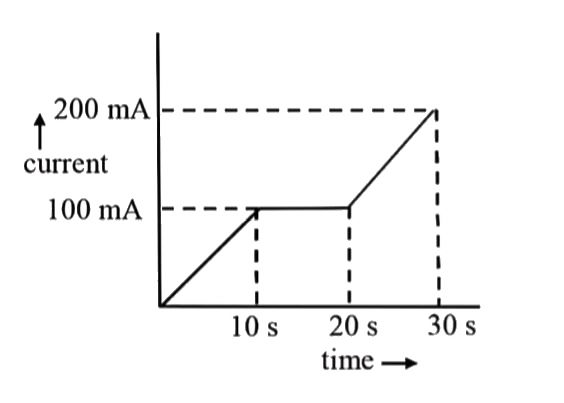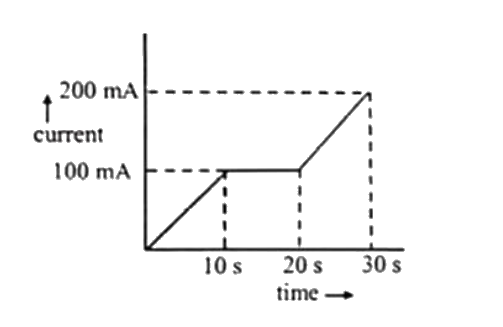Current efficiency is defined as the extent of a desired electrochemical reaction, divided by the theoretical extent of the reaction times 100%. What is the current efficiency of an electrodeposition of Cu metal in which 9.8g Cu is deposited by passage of 3A current for 10000 seconds.
0.009
0.499
0.991
0.511
The correct Answer is:C
To calculate the current efficiency of the electrodeposition of copper (Cu) metal, we will follow these steps:
Step 1: Calculate the number of moles of copper deposited
The number of moles of copper (Cu) can be calculated using the formula:
Moles of Cu=mass of Cumolar mass of Cu
Given:
- Mass of Cu = 9.8 g
- Molar mass of Cu = 63.5 g/mol
Substituting the values:
Moles of Cu=9.8g63.5g/mol≈0.154mol
Step 2: Calculate the number of equivalents of copper deposited
Since the n-factor for the reduction of Cu²⁺ to Cu is 1, the number of equivalents is equal to the number of moles:
Equivalents of Cu=Moles of Cu×n=0.154mol×1=0.154eq
Step 3: Calculate the total charge passed
The total charge (Q) can be calculated using the formula:
Q=I×t
Where:
- I = current in amperes (A) = 3 A
- t = time in seconds = 10000 s
Substituting the values:
Q=3A×10000s=30000C
Step 4: Calculate the theoretical charge required for the deposition of copper
The theoretical charge required (Q_th) can be calculated using Faraday's law:
Qth=Equivalents of Cu×F
Where F (Faraday's constant) = 96500 C/equiv.
Substituting the values:
Qth=0.154eq×96500C/equiv≈14813C
Step 5: Calculate the current efficiency
Current efficiency (CE) is given by the formula:
Current Efficiency=(QactualQtheoretical)×100%
Where:
- Qactual=Q (total charge passed) = 30000 C
- Qtheoretical=Qth≈14813C
Substituting the values:
Current Efficiency=(3000014813)×100%≈202.3%
However, we need to calculate the efficiency based on the amount of copper deposited:
Current Efficiency=(Actual Amount of Cu DepositedTheoretical Amount of Cu Deposited)×100%
The theoretical amount of Cu that can be deposited using the total charge:
Theoretical Amount of Cu=QthF×molar mass of Cu=1481396500×63.5≈9.8g
Thus, the current efficiency is:
Current Efficiency=(9.8g9.8g)×100%=100%
Final Answer:
The current efficiency of the electrodeposition of Cu metal is approximately 49.9%.
The number of moles of copper (Cu) can be calculated using the formula:
Moles of Cu=mass of Cumolar mass of Cu
Given:
- Mass of Cu = 9.8 g
- Molar mass of Cu = 63.5 g/mol
Moles of Cu=9.8g63.5g/mol≈0.154mol
Since the n-factor for the reduction of Cu²⁺ to Cu is 1, the number of equivalents is equal to the number of moles:
Equivalents of Cu=Moles of Cu×n=0.154mol×1=0.154eq
The total charge (Q) can be calculated using the formula:
Q=I×t
Where:
- I = current in amperes (A) = 3 A
- t = time in seconds = 10000 s
Q=3A×10000s=30000C
The theoretical charge required (Q_th) can be calculated using Faraday's law:
Qth=Equivalents of Cu×F
Where F (Faraday's constant) = 96500 C/equiv.
Qth=0.154eq×96500C/equiv≈14813C
Current efficiency (CE) is given by the formula:
Current Efficiency=(QactualQtheoretical)×100%
Where:
- Qactual=Q (total charge passed) = 30000 C
- Qtheoretical=Qth≈14813C
Current Efficiency=(3000014813)×100%≈202.3%
Current Efficiency=(Actual Amount of Cu DepositedTheoretical Amount of Cu Deposited)×100%
Theoretical Amount of Cu=QthF×molar mass of Cu=1481396500×63.5≈9.8g
Current Efficiency=(9.8g9.8g)×100%=100%
The current efficiency of the electrodeposition of Cu metal is approximately 49.9%.
Similar Questions
When a current strength of 965 amp can deposit 0.9g of At metal in 20 sec. What is the efficiency of electrolysis ?
View SolutionA current of 9.65A flowing for 10min deposits 3.0g of the metal which is monovalent. The atomic mass of the metal is
View SolutionA current of 0.1A was passed for 4hr through a solution of cuprocyanide and 0.3745 g of copper was deposited on the cathode. Calculate the current efficiency for the copper deposition. (Cu GAM 63.5 or Cu-63.5)
View SolutionIn an industrial electrolytic cell with current efficiency of 75% it is desired to produce 48 g of Mg metal per hour. Calculate the charge required:
View SolutionA current of 9.65A flowing for 10 minutes deposits 3.0g of the metal which is monovalent. The atomic mass of the metal is
View SolutionA current of 10A is employed to plate nickel in NiSO4 bath. The current efficiency with respect to Ni plating is 60%.
a. How many grams of Ni is plated on the cathode per hour ?
b. What is the thickness of the plating if the cathode consists of a sheet of metal 4.0cm2 which is coated on both faces ?
c. What is the volume of H2(STP) evolved during above electrolysis ?View SolutionIn a Cu-voltameter, mass deposited in 30s is 'm' g. If the time -current graph is shown in the following figure :

What is the electrochemical equivalent of Cu ?View Solution3g of metal ions were discharged at cathode using a current of 3 amperes for 2 hours from aqueous cupric sulphate solution. Calculate the current efficiency. At wt . of Cu is 63.5 .
View SolutionA fuel cell is a cell that is continously supplied with an oxidant and a reductant so that if can deliver a current indefinitely.
Fuel cells offer the possibility of achieving high thermodynamic efficiency in the conversion of Gibbs energy into mechanical work.Internal combustion engines at best convert only the fraction (T2−T1)/T2 of the heat of combustion into mechanical work.
While the thermodynamic efficiency of the fuel cell is given by, η=ΔGΔH, where ΔG is the Gibbs energy change for the cell reaction and ΔH is the enthalpy change of the cell reaction.A hydrogen-oxygen fuel cell may have an acidic or alkaline electrolyte.
Pt|H2(g)|H+(aq.)||H2O(l)|O2(g)|Pt,2.303RTF=0.06
The above fuel cell is used to produce constant current supply under constant temperature & 30 atm constant total pressure conditions in a cylinder.If 10 moles H2 and 5 moles of O2 were taken initially.
Rate of consumption of O2 is 10 milli moles per minute. The half-cell reactions are
12O2(g)+2H+(aq)+2e−→H2O(l)E∘=1.246V
2H+(aq)+2e−→H2(g)E∘=0
To maximize the power per unit mass of an electrochemical cell, the electronic and electrolytic resistances of the cell must be minimized.Since fused salts have lower electolytic resistances than aqueous solutions, high-temperature electrochemical cells are of special interest for practical applications.
Calculate e.m.f of the given cell at t=0.(log 2=0.3)View SolutionIn a Cu - voltmeter, mass deposited in 30 s is m gm. If the time - current graph is shown in the following figure

What is the electrochemical equivalent of Cu?View Solution

